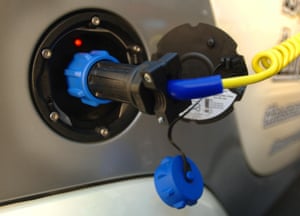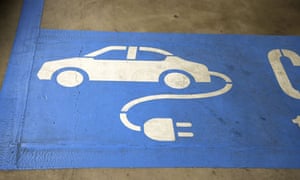Extract from The Guardian
Why has it taken so long just to move past the bare minimum needed to support what is now an expanding sector?
Last September, Sylvia Wilson became the second person in the country to drive around Australia in an electric car.
The entire 20,396 kilometre trip took the 70-year-old 110 days in her Tesla S75 and cost just $150.90.
Her success served as an answer to critics who have long argued
“range anxiety” – the worry about whether an electric car’s battery will
die out of reach of a charging station – is a factor stopping more
people buying electric cars.The entire 20,396 kilometre trip took the 70-year-old 110 days in her Tesla S75 and cost just $150.90.
“The reality is that if you can see the lights on or that the kettle works, then you can charge. Even in the remotest places, you can still charge the car. In a way there are more places to charge an EV [electric vehicle] than there are a fossil-fuel car,” Wilson told Guardian Australia at the time.
Behyad Jafari, chief executive of the Electric Vehicle Council, says the failure to so far provide this infrastructure – from charging stations and uniform standards for components, to the tools needed to maintain each vehicle – is a symptom of political paralysis that has taken hold in Canberra.
“Let’s be clear here, these aren’t electric vehicle problems, they’re Australian policy problems,” says Jafari. “In the absence of that, companies are left wondering, well what the hell do we do?”
According to modelling commissioned by the Clean Energy Finance Corporation, most electric car owners will charge at home or at their place of work but roughly one in three will still be reliant on public charging stations. With just 783 charging stations around the country in 2018, compared with 6,400 petrol stations, building the infrastructure to support the widespread take-up of electric vehicles will cost $1.7bn.
Tim Washington is chief executive of Jetcharge and Chargefox, one of the biggest companies in Australia which supplies and installs charging stations across the country.
Washington says most of the infrastructure needed to support the mass uptake of electric cars is already in place, because most people living in a city only drive up to 30 kilometres a day.
“Public charging stations are a visual signal to the public that you are now able to charge the car. People are very used to seeing petrol stations and they have confidence in buying a petrol car because they have a petrol station,” says Washington.

“They’re in homes, in basements, in commercial building car parks, in public car parks – in all the places where you don’t see a traditional fuel source – and that’s all that required for a healthy uptake of electric vehicles.”
The problem for companies like his, Washington says, is that the infant nature of the industry and the way people will use the technology makes it a risky investment.
“One of the troubles for public infrastructure providers is that you invest all this money to encourage people to come to electric, but once you invest this money, people will charge at home,” Washington says.
“It’s classic market failure.”
To get around this, state and local governments have so far been eager to support the building of new charging stations, but often the support they can provide is limited by their resources and their authority.
Last October the federal energy minister, Angus Taylor, announced $6m to support Chargefox in building a network of ultra-fast charging stations along the highways that link Brisbane, Sydney, Canberra, Melbourne and Adelaide, and four around Perth.
These stations have the ability to take recharge times from eight hours down to 15 minutes in some cases.
While it was a welcome announcement, the government has so far failed to address other infrastructure issues that aren’t the most obvious – or headline grabbing.
An early example involved the humble plug.
With no clear standard in Australia, global manufacturers had no guide for how to build their cars for the local market.
In some ways it risked repeating what happened at federation when each state mandated its own rail gauges, making it impossible to take a train across state lines in one continuous trip.
“It had been an understood issue for quite a number of years before but then there hadn’t been any action,” says Jafari.
Instead, industry players themselves had to organise to decide on a voluntary standard that was later communicated in a technical document released by the Federal Chamber of Automotive Industries.
While it was a good news story for the industry, it should never have been left to get that far.
Now researchers such as Professor Iftekhar Ahmad from Edith Cowan University are looking ahead to stop future problems before they happen.
“Electric cars will increase what’s called high peak-to-average demand. When the owners go home and plug in, we’ll see high peak demand during those hours,” says Ahmad.
“The current distribution network is not designed for high peak. When you think about putting so much load on the network, the infrastructure lifetime can be shortened and also it can put too much stress on transformers.”
While several fixes have been proposed, Ahmad says the problem can be overcome with proper planning.
“It has to be well planned,” he says. “It’s not currently happening in a coordinated fashion and the perspective from the government [and] the utilities is that there’s not enough cars in the market to think about it.
“It will happen, there is no stopping it. If you go to Beijing or Europe, you will see them everywhere and if enough planning can be done, electric cars have a huge potential to complement our renewable energy system.”

No comments:
Post a Comment